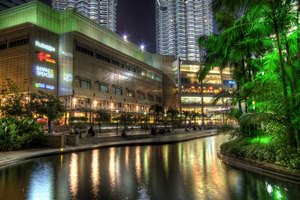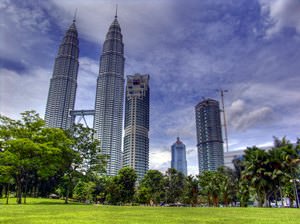 Any guide of Kuala Lumpur would be incomplete without a review of its most impressive architecture monuments - Petronas Twin Towers, Sultan Abdul Samad Building, National Museum Kuala Lumpur, Bukit Jalil National Stadium, National Textiles Museum and many others. It’s difficult to overestimate their historical and cultural importance for Malaysia. The style and architecture of any of these landmarks are worth a visit when you are on vacation in Kuala Lumpur. However, you can virtually visit any of these wonderful monuments without leaving your comfortable chair. For that purpose, simply 'fly' over the 3D model of Kuala Lumpur that was created by OrangeSmile and GoogleEarth. All you need to do is to click the video on this page.
Any guide of Kuala Lumpur would be incomplete without a review of its most impressive architecture monuments - Petronas Twin Towers, Sultan Abdul Samad Building, National Museum Kuala Lumpur, Bukit Jalil National Stadium, National Textiles Museum and many others. It’s difficult to overestimate their historical and cultural importance for Malaysia. The style and architecture of any of these landmarks are worth a visit when you are on vacation in Kuala Lumpur. However, you can virtually visit any of these wonderful monuments without leaving your comfortable chair. For that purpose, simply 'fly' over the 3D model of Kuala Lumpur that was created by OrangeSmile and GoogleEarth. All you need to do is to click the video on this page.
Petronas Twin Towers, Kuala Lumpur
Location on the map:  Facts:
Facts:
» The Petronas Towers are the highest twin towers in the world. They have 88 floors and are 452 m high. » According to the project, the buildings feature a huge size and a complicated structure. Their foundation is 100 m beneath the ground and is the deepest in the world.
» The towers are connected by a glass bridge that is situated at a height of 170 m. There is also an observation platform. As the towers swing, the bridge joint with ball bearings moves too.
» Due to a lack of space for lifts, there are two two-level lifts in each shaft. One lift stops on even floors and the other - on odd floors.
» The twin towers were built in the shape of octagrams according to Islamic canons.
» The construction was completed in 1998. There are offices, conference halls, an art gallery, a concert hall, and a shopping center. 10 000 people work here.
» The towers are open to visitors. Here, they can learn about the building, visit an observation platform and a glass bridge.
» The towers received the Aga Khan Reward for Islamic Architecture.
Sultan Abdul Samad Building, Kuala Lumpur
Location on the map:  Facts:
Facts:
» The Sultan Abdul Samad Building was built in 1897. At that time, Sultan Abdul Samad ruled one of the Malaysian states. The opening ceremony was visited by him and the governor. » The building was designed by an English architect A.C. Norman. His surname is engraved on the building foundation.
» At that time, this palace was the biggest and longest in Kuala Lumpur. It is 137 m long.
» The most impressive part of the building is a 43-meter clock tower. It is even called “Big Ben”.
» In 1957, the British flag was hoisted down on the palace and Malaysia was declared independent. Since that time, Independence Day has been celebrated in the square in front of the building. Here, other cultural events also take place.
» In the building, there are municipal administrative offices. Now, it is occupied by the Ministry of Culture.
» The luxurious palace attracts tourists especially at nights when it is illuminated and turns into a building from Eastern fairy tales.
National Museum Kuala Lumpur, Kuala Lumpur
Location on the map:  Facts:
Facts:
» The National Museum in Kuala Lumpur is the most significant history and ethnographic museum in the country. It was founded in 1898 when the government of the British colony found a museum in Selangor. » In 1945, the building was damaged and bombed by American soldiers. It was restored only in 1963.
» The museum includes four sectors. The first one is dedicated to the ancient history of Malaysia. Here, you can see Palaeolithic ware, ceramics, and tools. There is also a skeleton of a person who lived 10-11 000 years ago.
» In the second gallery, you can learn about the reign of the sultan and the development of a peninsula located on the trade route.
» The third section houses exhibits of the colonial period that lasted from 1511 to 1945.
» The fourth one is dedicated to the recent history of the country.
» In the National Museum, there are a lot of interesting exhibits. Some of them are displayed outside the museum. For example, you can see the first palace of the sultan (Istana Satu) here. It is a Malaysian house built on piles without nails.
Bukit Jalil National Stadium, Kuala Lumpur
Facts: » The Bukit Jalil National Stadium is a multifunctional stadium in Kuala Lumpur.
» In 2007, the Bukit Jalil National Stadium was one of the stadiums that hosted the AFC Asian Cup. Here, seven matches of the tournament, including a semi-final between Iraqi and South Korean teams.
» Bukit Jalil is the biggest stadium in Malaysia. It accommodates 110 000 spectators.
» The Bukit Jalil National Stadium was built in 1998 specifically for the beginning of Commonwealth Games. During them, the stadium served as a part of a big sports complex.
» Here, finals of the Malaysia Cup and Super League are always held.
» The national stadium is the fourth most capacious in the world.
» Now, the Bukit Jalil Stadium and the National Sports Complex are being renovated. The restoration costs over $15 million. They were restored in two stages within the framework of the KL Sports City project. The first stage was completed ahead of schedule. The exterior of the stadium was renovated and redesigned. Now, it has twisted vertical lamellas and modern lighting. Seats were painted black and yellow. All equipment was modernized. After the 2017 ASEAN Para Games, the second stage will begin. A new sliding roof, sliding seats, new sports equipment, and modern air vents will be added.
National Textiles Museum, Kuala Lumpur
Facts: » The National Textiles Museum is located in a building built in 1896. This house designed in the Neo-Moorish style is very attractive and spectacular. It is decorated with many towers, shaped arches, and spires.
» The museum houses the collection of textiles. It is divided into four sectors.
» In the first one, there are ancient tools used to make fabrics. Here, you can also see such rare fabrics, as keringkam, songket, and pua kumbu.
» In the second sector, outfits of representatives of different Moorish strata are displayed. Patterns and fabrics indicated the social status of a person.
» In the third gallery, you can see the full diversity rich heritage of Malay textiles.
» The most interesting sector is the fourth one. It houses jewels, clothes, and accessories that belonged to different ethnic groups of the country.






